Over the Independence Day weekend and into the following week, I went on a solo backcountry trip through the Yosemite Wilderness. Thanks to a recommendation from Ben Mathes I started at Tuolomne Meadows and went in through Young Lakes. I didn’t have a route planned, intending to make it up as I went along. This was both my first solo trip – which I’ve been talking about doing for years – and my first trip spending time off trail.
Play along at home with this CalTopo map, or skip the story and go straight to the gear section. I don’t carry a camera so all trip photos are representative.
Pregame
Wilderness permits needs to be picked up by 10am the day of, so I drove up a day prior. Good thing too! Being a holiday weekend it took over an hour to get through the park entrance, making total trip time from San Francisco to Toulumne Meadows six and a half hours. With my permit and rented bear canister taken care of and the rest of an afternoon to kill, I drove back down to Tenaya Lake with my hydrapak for a quick jaunt up to Clouds Rest and back.
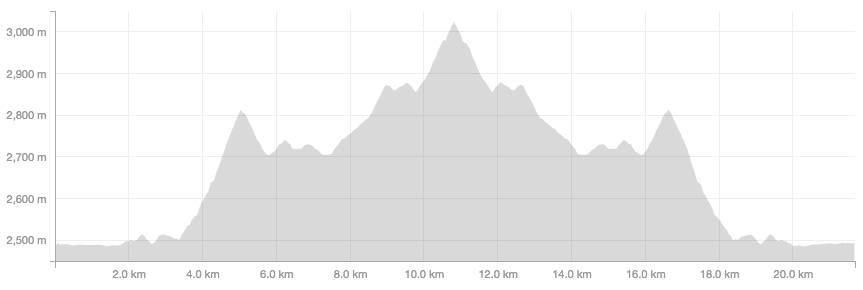
This felt much stronger than I anticipated at altitude, and on completion I dunked myself in the lake. Then the trouble started. Driving back I started to feel nauseous and had to pull over. I managed to get up and back to the Meadows campground, but the nausea kept getting worse. Was it the altitude? Hydration? The four-year old backup Peanut Butter Gu I’d finally consumed on the descent? Either way it took me an hour to get my tent up, with most of that spent just lying on the ground sheet. I skipped dinner and went to sleep without even inflating my sleeping mat.
Not the most auspicious beginning.
Day 1
Thankfully woke up feeling fantastic. My bear canister was slightly too small to fit all of my food, which of course meant dinner for breakfast! Tried out my peanut noodles, of which I’d forgotten to actually make the sauce so was literally just peanut butter and two-minute noodles. Not great, but calories are calories. Also found a couple blocks of chocolate while cleaning out the car of bearables, which I shared around with my fellow hikers. Nobody says no to chocolate for breakfast. All told, in addition to what I just ate I had to leave behind two bars, half a block of noodles, and about a third of my dried fruit.
I’d planned an easy day with a short hike into Young Lakes to camp, then some off-trail exploring in the afternoon to get a feel for things. I added a lap of Dog Lake on the way, where I discovered an amazing population of blue dragon flies. After setting up camp on a small flat ledge uphill from the lake, I followed the contour line around to meet up with the river. From there, some pretty serious bush bashing and back tracking was needed to get to the source: a small glacier nestled in a valley below White Mountain. Coming back down the other side was easier, and I kept running into (and failing to follow) a cairned trail someone had left.
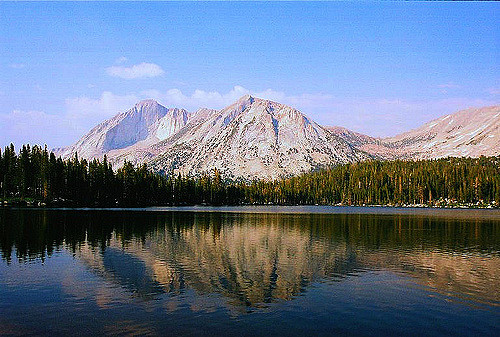
With some sunlight left I sat on a rock to watch the sunset over the lake. It took ages. Aaaaaaages.
Distance: 13K (+590m) with pack, 5K (+280m) without
Day 2
Heading north towards Roosevelt Lake, a botched river crossing left me with wet feet to start the day. The first unexpected terrain was a field of large boulders that forced me downhill towards the river to get around. If only all of the day’s obstacles were so easy…
After a pleasant walk across a meadow to the lake, I made an ill-advised decision to pass by on the eastern side. While barely a few hundred metres, it was a solid traverse across steep, loose, large rocks that felt like they were going to collapse down on top of me at any moment. I also had to go up and down a few times to avoid large snow deposits. It must have taken me an hour or two to get across. I was pretty nerve-wracked by the end, and comparatively thrilled for the climb to the pass.
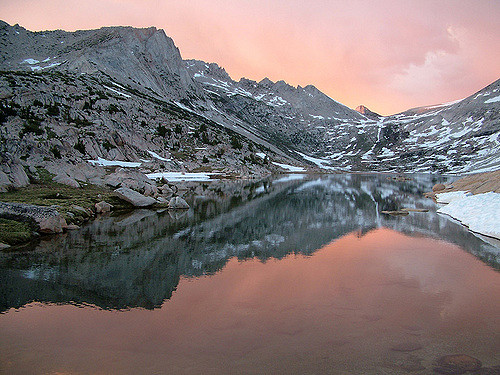
The view from the top of the pass was stunning. And scary: the steep descent was completely covered in snow. This I did not plan for. I grew up near the coast, have never even been skiing, and don’t know the first thing about snow. Can I hike on it? On the flat, sure, but what about an incline? Would I just slide all the way down into the lake? How stupid is this? I tried a few tentative steps by stomping into the snow to form ledges, and by sticking close to the exposed rock I edged my way down.
My confidence boosted, I attempted to cross a short gap between two rocks – and promptly had both my legs fall through the snow down to my waist. My right leg came out fine, but I had to spend some time digging out my left. While the snow was generally about a metre or two thick, near the rocks some of it had melted out from underneath. Lesson learned! Once down to the lake, I was mostly done with snow and able to stick mostly to rocks.
The descent down to McCabe Creek was pretty straight-forward. Following it around opened up into a beautiful meadow, then another river crossing to meet with the trail up to lower McCabe Lake. My original plan was to camp here, but there was still plenty of sunlight and it had felt good to hike on trail after a full day sliding around. I headed back down the trail, joined up with the PCT, and settled for the night at the Virginia Canyon junction.
In hindsight, I chose my campsite poorly. It was in a depression which invited dew, the cold, and mosquitos. I spent some time in my tent taking notes and going over maps before retiring at what felt like almost sunset, but it was still hours until the sun went down. Two nights in a row I’d misjudged the time, so resolved to start using my watch.
Distance: 17K (+685m)
Day 3
After yesterday I felt like spending a day on the trails. First I set off up Matterhorn Canyon, thinking I would loop up around Peeler Lake and down through Kerrick Lake. It begins with a number of crossings (wet feet again!) then meanders up the creek.
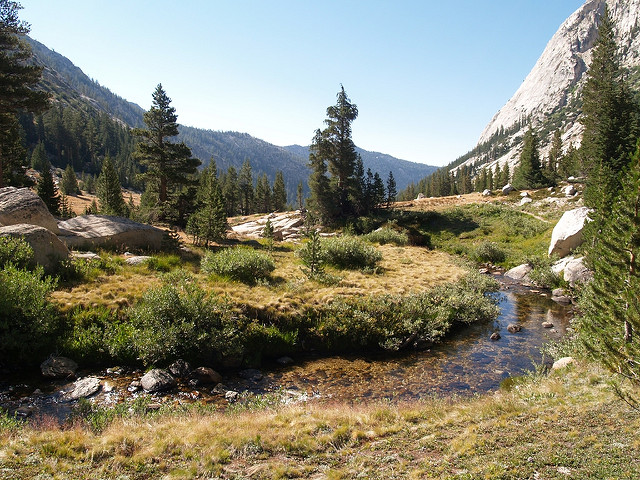
After a tough final push up to Burro Pass I discovered something I’ve never seen before: the trail blocked by a solid wall of snow, as tall as I was. I climbed on top of it and traveled a small distance to sight the upcoming trail and it was more of the same: snow, snow, and more snow. Judging from my map, the next one (Mule Pass) would be more of the same. While the slope was much more forgiving than yesterday, neither my feet nor my nerves were feeling up for it. I turned back around.
Getting back to the PCT with a few hours of sunlight left, my new plan was to reach Smedberg Lake.
Cresting Benson Pass was a highlight of the trip. The exhiliration of finishing a climb and an incredible view mixed with the relief of finally finding a pass that wasn’t covered in snow!
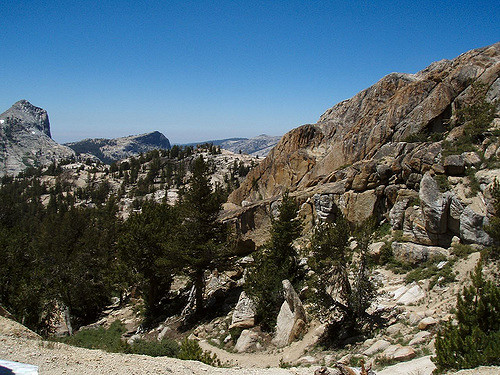
Smedberg Lake hosted the most dense population of mosquitos I encountered. Inexplicably I found a couple camped right in the thick of it. “Lot of bugs!” they remarked. THAT’S BECAUSE YOU SET UP CAMP IN A SWAMP. I hiked past them, up and over a rise, to find my best campsite of the trip: great view, warm, and relatively bug free.
Dinner was the maligned peanut noodles, which a 40K day had wondrously transformed into a contender for best meal of the trip.
Distance: 39K (+1620m)
Day 4
The Rodgers Canyon trail wandered off the edge of my map, but looked like it should connect up with Tuolumne Canyon pretty quickly so I took a chance. It did … eventually. The descent down into (what I discovered later was) Pate Valley was pretty miserable. Endless switchbacks, overgrown trail, no view, and just steep enough to destroy any rhythm. I hadn’t seen anyone else on trail all day, and didn’t know if the trails would even link up.
My heart was buoyed around lunch time coming across an AmeriCorps crew on trail maintenance duty. They confirmed the trails did link up and my descent wouldn’t have to be reversed. I hit the signposted junction around noon: Glen Aulin, fourteen miles; Tuolumne Meadows: twenty one.
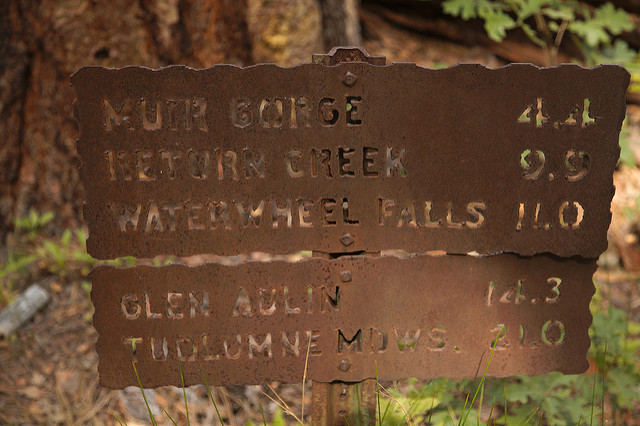
Which is when I got a crazy idea.
With nine hours of daylight left, it appeared possible I could leg it all the way back to the Meadows today. The pace would have to be fast, but seemed within the realm of possibility.
The start of the canyon trail was another highlight of the trip. Well constructed trail up a pleasant grade, alongside the roaring Tuolomne river. I set out aggresively.
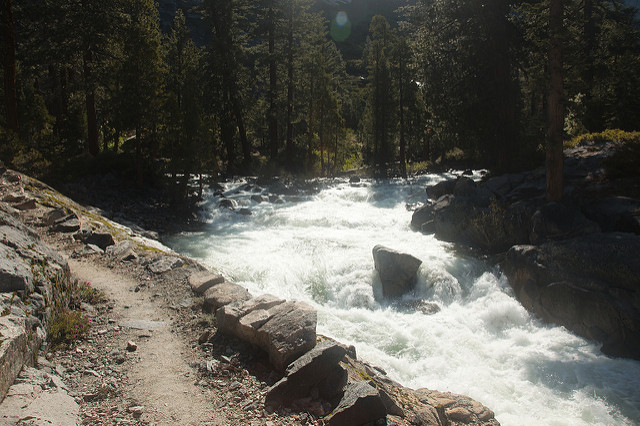
By my map, there was a footbridge a little over half way. I hit it feeling strong, and hammered up the following switchbacks. Fatigue was starting to set in to my legs, feet and back as I neared Glen Aulin, but I knew from there to the Meadows would be a relatively easy hike, so keep pushing, keep pushing. It was hard work, but we do these things not because they are easy.
And then I hit the footbridge. The real footbridge. Oh dear.
Looking back over my map now, the first bridge was likely the unmarked river crossing at the very edge of where I got back on map. I’d dug deep to get here, and was about to pay for it. The trail only got steeper.
What had been a steady ascent became a grinding slog. Waterfall after waterfall, switchback after switchback. My self-imposed cut off time for Glen Aulin was 6pm. Realising at 5:30 I wasn’t going to make it, I eased up my pace. I arrived at Glen Aulin at 7, my feet completely done for and honestly thankful I was finished for the day.
Distance: 40K (+1600m).
Day 5
An easy exit along the PCT. I technically could have stayed another night, but with two consecutive hard days and a race on Saturday I opted for a day of rest on Friday instead.
Distance: 12K (+435m)
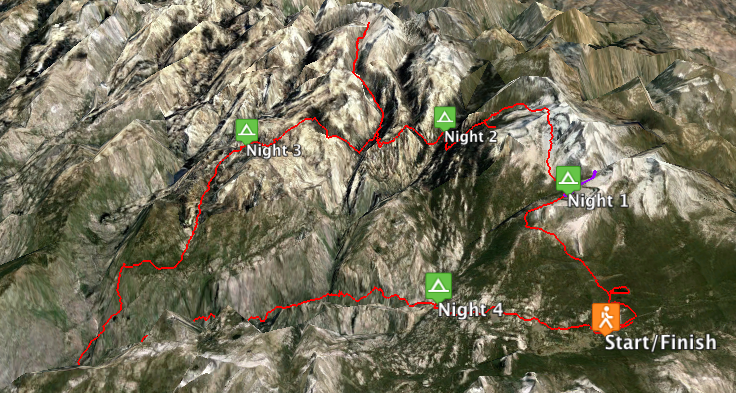
Gear
I carried about 16kg on my back, though my itemized listing sums to slightly more. Not sure why. This is my first vacation in a long while, so I splurged somewhat on new kit.
Storage
I’ve had my Blackwolf Odyssey 65L pack for about a decade and a half by now, and it looks it. It has been heavily used for all my travel and backpacking in that time, and I’ve only needed to replace the waist clip. It’s a tank. For this trip, I removed the detachable 10L day pack and lined it with a regular garbage bag. If I were to replace it, I’d be looking for water access from the front without stopping (either a reservoir or pockets), and likely something a bit lighter. I also don’t use the interior divider that can be used to separate the bag into two sections.
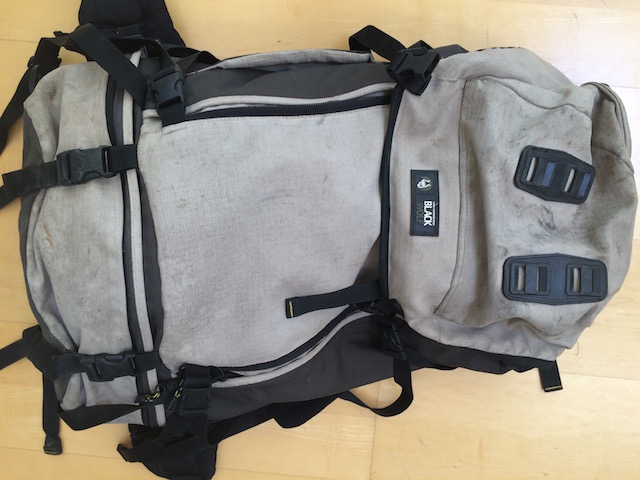
I rented a bear canister from the Wilderness office for $5, which I’m pretty sure was a Garcia Backpackers’ Cache. It was opaque and didn’t quite fit all my food. I was envious of the BearVault BV500 I saw others with, but in the end the Garcia worked fine.
Clothing
My Sierra Designs shirt was a standout new gear item of the trip. I can’t find fault with it. It was cool to hike in even in the sun, didn’t have any annoying seams, and wasn’t too gross even on day five. Highly recommended. As an alternate I took a capilene t-shirt with separate arm sleeves, but never felt like using them.
I hiked in Mountain Wear pants that I’ve had for a while. They sagged around the waist as the day wore on which was a minor annoyance. They zip off to shorts, though I didn’t take advantage of this. Mosquito and brush protection was worth keeping them long, and this also reduced the need for gaiters. For a replacement I’d look for a lighter material, and wouldn’t take the shorts zip. If I want to keep a shorts option open I’ll carry running shorts instead.
Two pairs of Ex Officio briefs were a little pricey, but performed well. I washed the alternate each day and dried it on the outside of my pack. I also carried a microfiber towel which was helpful to accelerate drying, both of clothes and myself.
The back of my wide-brimmed hat hit the top of my pack if I was sloppy in packing it down. Not too annoying, and I could work around by tucking the back of the rim up under my head, but I’m considering trying out a legionnaries hat next time.
Locomotion
Salomon’s Sense Pro 2 were easily the most comfortable out of the dozen or so pairs of trail shoe that I tried. I use these primarily for running, but they work for hiking too. I was initially lukewarm on the lacing system but it’s grown on me. I combined them with Injinji toe socks, of which I had a spare pair packed that had dissappeared by the time I reached Young Lakes. As a result I had a hard time keeping my feet dry. I was basically hiking with wet feet for the first three days, which combined with sliding around off trail caused some minor blisters. Historically I’ve used bandaids to manage blisters, but for this trip I was carrying a roll of 0.5” Micropore surgical tape. It was a winner! While it did leave a bit of sticky residue, it stayed put even through a full day of damp hiking. I replaced it everyday, though likely didn’t need to. I had to buy a 24-pack, so I’ll be giving them out as presents for the foreseeable future.
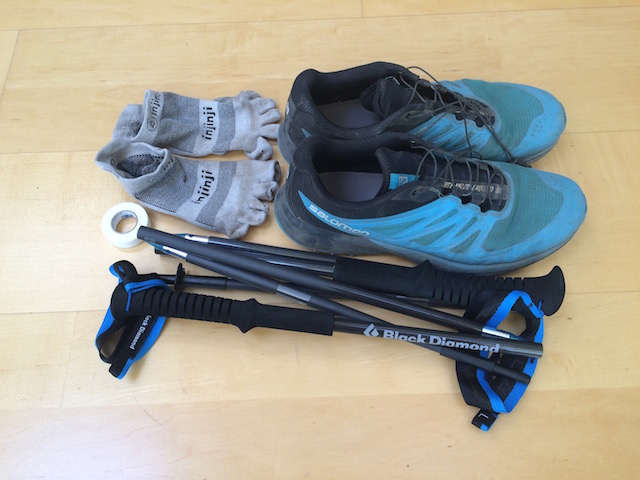
This was also the first trip I’ve tried hiking poles. I didn’t realise how much of a cheat they are! Climbs are so much easier, and even on flat ground they really propel you along. I avoided them for technical descents, as I found they made my footing generally worse.
Sleep and Shelter
I continue to have no substantive complaints with REI’s Dash 2 Ultralight tent (no longer available), though I added aftermarket TNH stakes which are both lighter and more sturdy than the stock ones. I also haven’t had the opportunity to trial it in inclement weather yet.
The Neoair sleeping mat is also good (sans pump, just blow it up yourself), and I realised this trip it was easier to just roll it up and pack in my tent as a stick, rather than folding it in thirds to fit into the provided sack.
I’ve put off buying a proper sleeping bag for a while now, so this trip I finally made the commitment. I went with Sierra Design’s Backcountry Quilt and am glad I did. As both a restless and a hot sleeper I’ve never been that comfortable in bags. The quilt let me control temperature easily, and didn’t get tangled up as I rolled around. I used the hood on the third night when I picked a cold site, and it worked well.
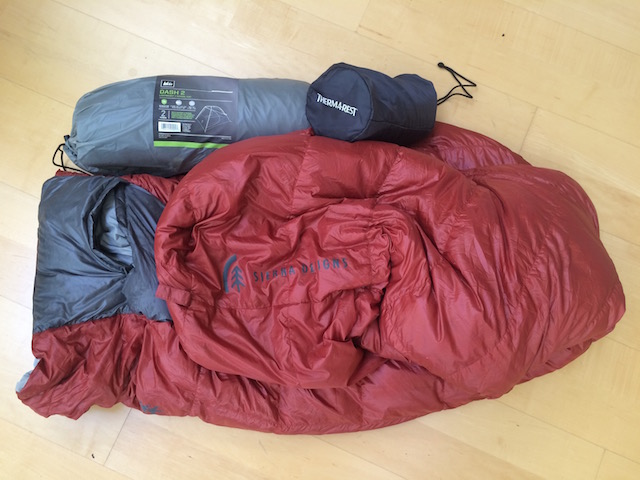
Since I try to avoid products of animal suffering, I wasn’t thrilled with buying a down product, but they are far more durable, warm, and light than synthetic alternatives. Sierra Design’s down is traceable back to factories that don’t use live plucking, and it is completely a by-product of the meat industry. Down typically accounts for less than 10% the value of a bird. I also picked up a down hoody which is much warmer than any other piece of clothing I own.
Hydration
Something old and something new. My Sigg 750ml I’ve had about as long as my pack, and I bought a new Vapur 1L for this trip. I used the latter as my primary since it clipped on to the outside of pack for easy access. It wasn’t very satisfying though. It was difficult to fill completely from streams, the flip lid tended to get in the way when pouring, as did the lack of stability, and I kept needing to reset the plastic clip. I’d like to investigate getting a metal clip for either it or the Sigg for future trips, because the external access was very handy. (I could also fix that with a different pack.)
I was carrying Aquamire decanted into small dropper bottles to treat water, but didn’t use it much. That may be irresponsible – it’s certainly against official recommendations – but I figure it’s safer than driving. The water in Yosemite this time of year is all flowing fast and has literally just come from glaciers. I used Aquamire once when I collected water from a more stagnant lake and it was tasteless as advertised, but generally there were plentiful rivers along the route and I typically refilled my 1L multiple times a day.
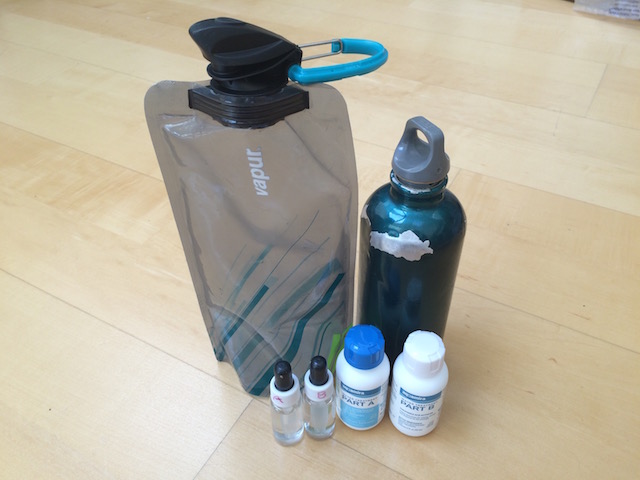
Electronics
Jodie’s review of the Spot Gen3 tracker I carried:
Having just listened to a podcast about a serial killer targeting backpackers it was reassuring to see my husband’s check-ins and go to sleep knowing he’d be able to hike another day.
And my mother’s:1
Why did you go by yourself? Don’t you have any friends? Also, treat your water.
If I stuck to common trails I wouldn’t need it, but for off trail a tracker with SOS functionality seemed prudent. Reconciling when I got back it seemed to not have recorded some updates. Likely because I didn’t wait long enough for the GPS to lock? The only other electronics I carried were a watch and a headlamp.
Miscellaneous
I treated my shirt, pants and hat with Permethrin and it worked a treat. No mosquito issues to speak of. I carried Deet for exposed hands and ankles, but only used it once mostly to say I did. Despite active bug populations, I only suffered three bites the whole trip: one on my ankle, and two on my thigh when I was taking a dump. The little fuckers have no mercy.
I carried ninety-six sheets of toilet paper. Four per evacuation, two of those a day, doubled for safety. That math basically worked. I doubled bagged in ziplocks to carry out. After accidentally ordering ridiculously large 8oz packs of Purell hand sanitizer (claiming four nines of germ eradication!), I found a more reasonably sized 2oz random brand at Rainbow at only three nines. What does that number even mean!? I figured anything was a step up from just wiping my hands on my pants, right?
Food
Without a solid plan, I carried a full six days of food, minus what didn’t fit in the bear canister per above. I cooked with an MSR WindPro II stove, which always surprises me how fast it boils. I went through just over a quarter of an 8oz fuel cannister over eight meals. (I don’t drink coffee or tea.)
Breakfast
Porridge. It works. Though I am getting kind of sick of it, and the last cold bite is always a bit rough. Don’t feel like I need a hot breakfast, would prefer to just start walking. The volume to weight/calorie ratio is hard to beat though.
Lunch and Snacks
The first two days I only ate one wrap for lunch rather than two, but the longer days three and four got my appetite going. It was a pain to unpack my canister to make them, so on day four I made them in the morning with breakfast and carried in the top of my pack. Much better. Not sure whether I prefered the almond or peanut butter variant.
Pre-made bars were my luxury item. High in calories, but also pricey. I sampled a number of brands, but after field testing the standout winner was Probar’s Peanut Butter Choc Chip. It was always what I felt like. Actually I might eat one now…
Dinner
As mentioned above, peanut noodles were the subjective favourite of the trip though in hindsight I still can’t quite believe my own notes. Curry lentil soup was good, though just as bulky as noodles. Rice and cashews was the most compact and cheapest, but also the least tasty and took longer to cook. All three I would take again though.
All in all a solid trip. Time to start planning the next one!
-
Both women wish it to be known that these comments are not actual quotes. I maintain that, like the photos, they are representative. ↩